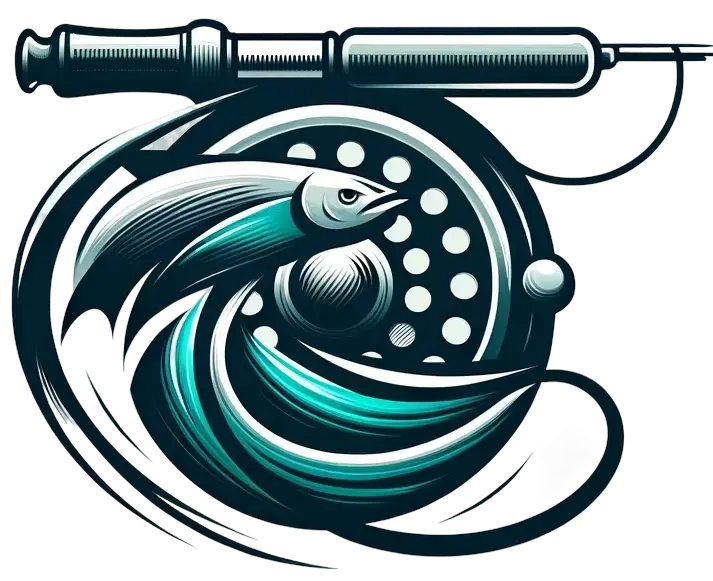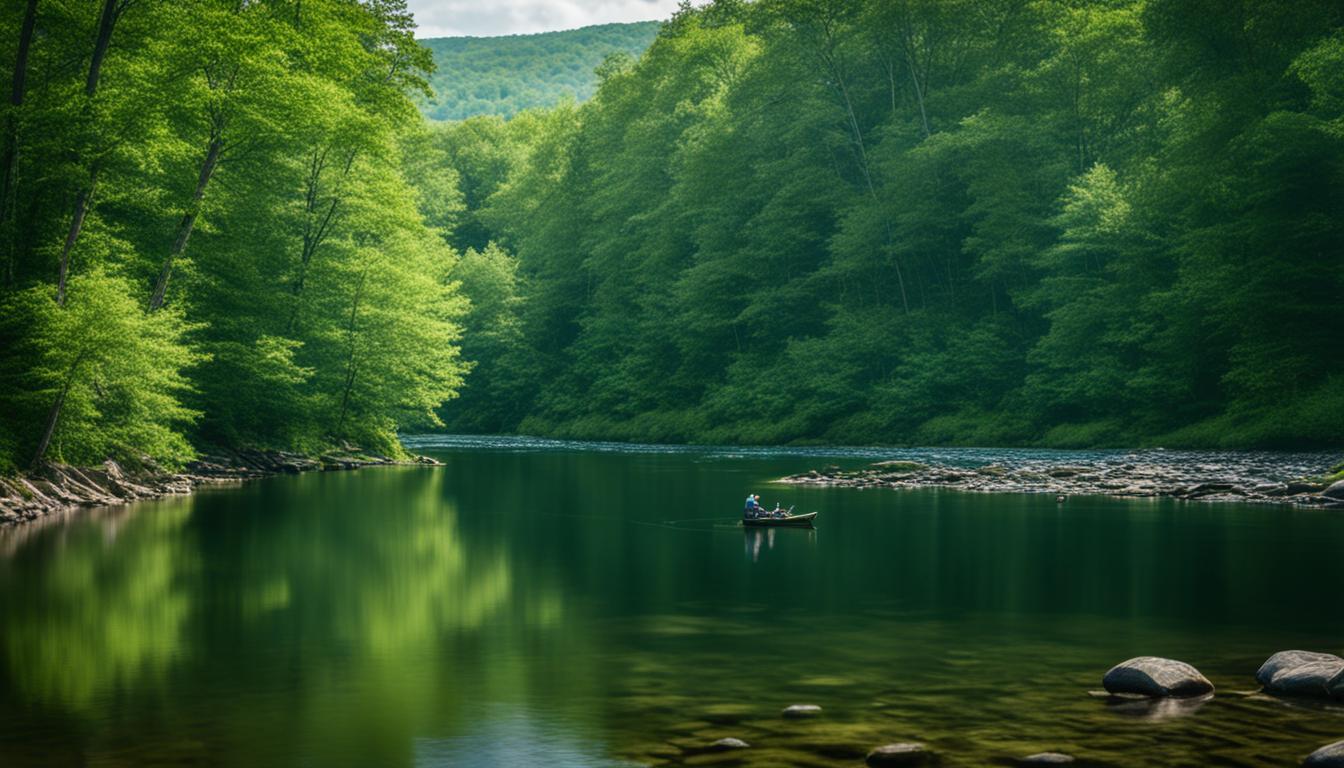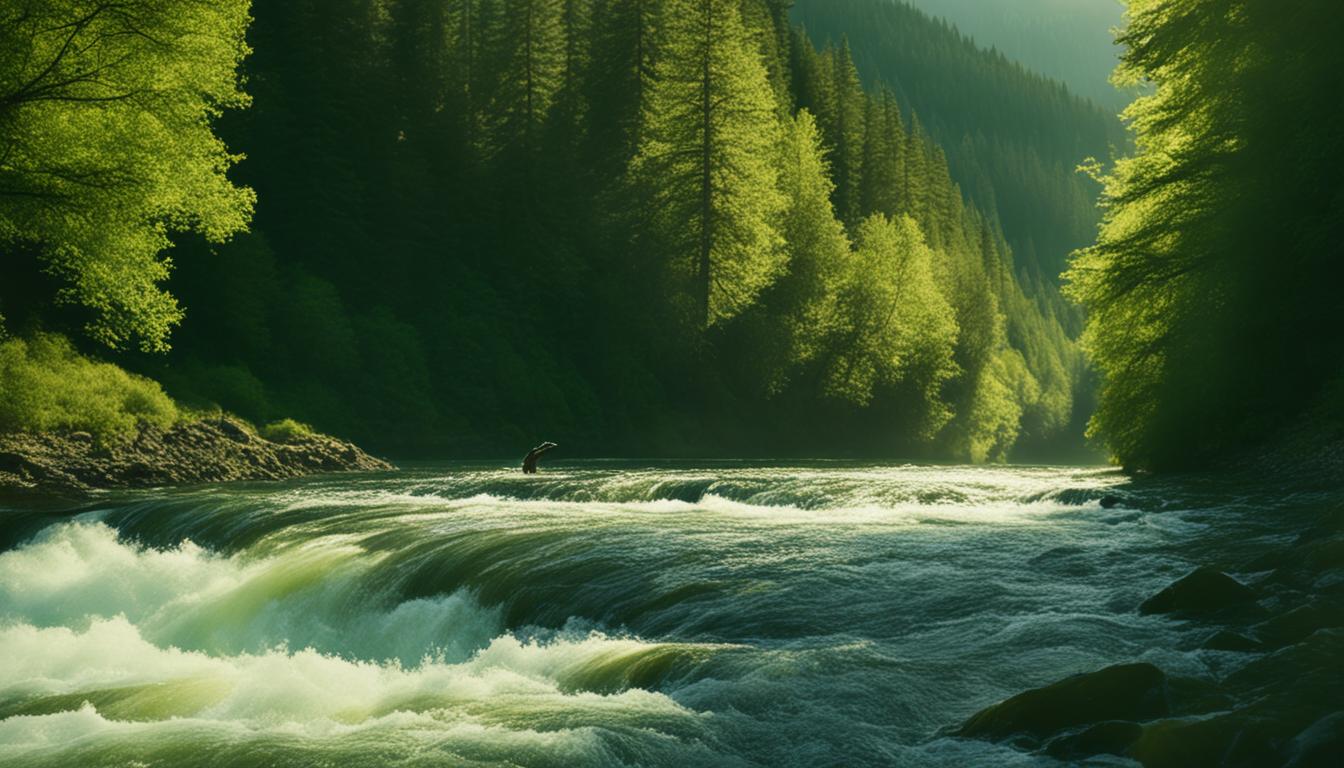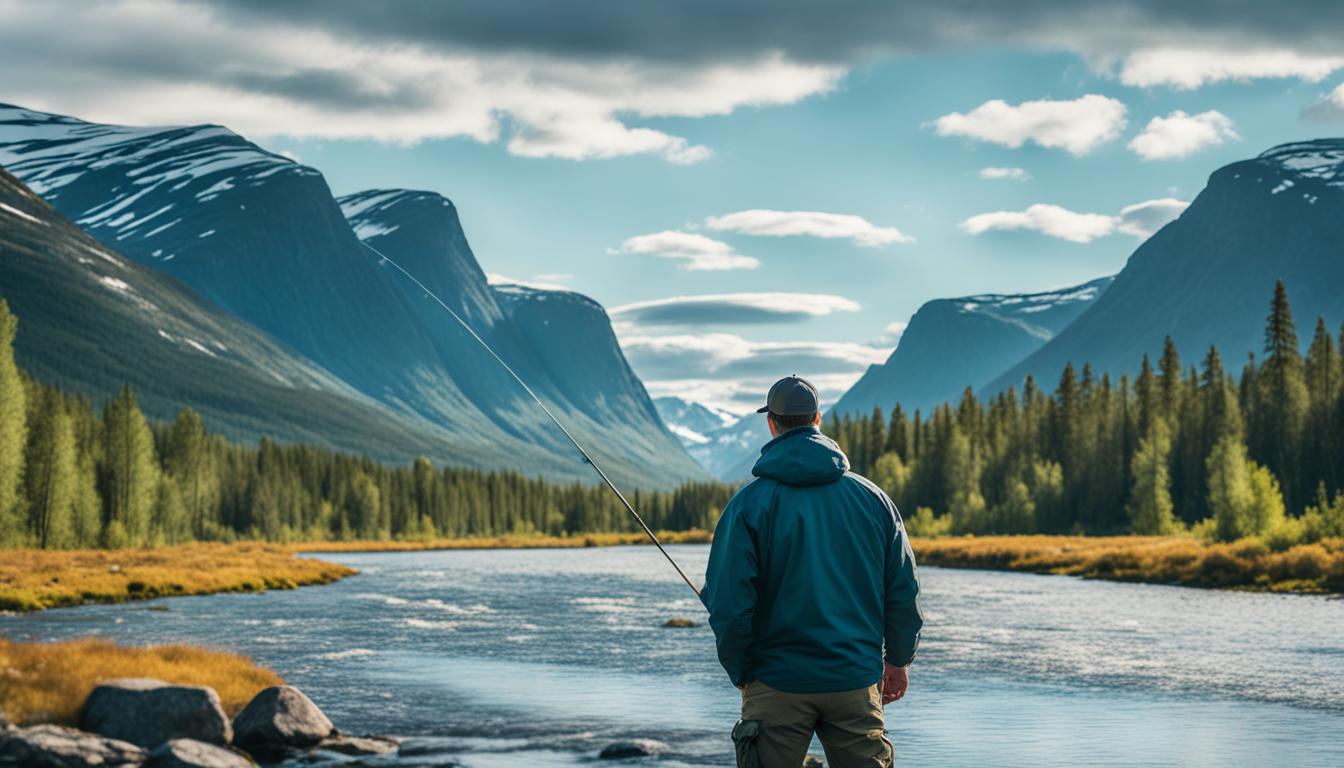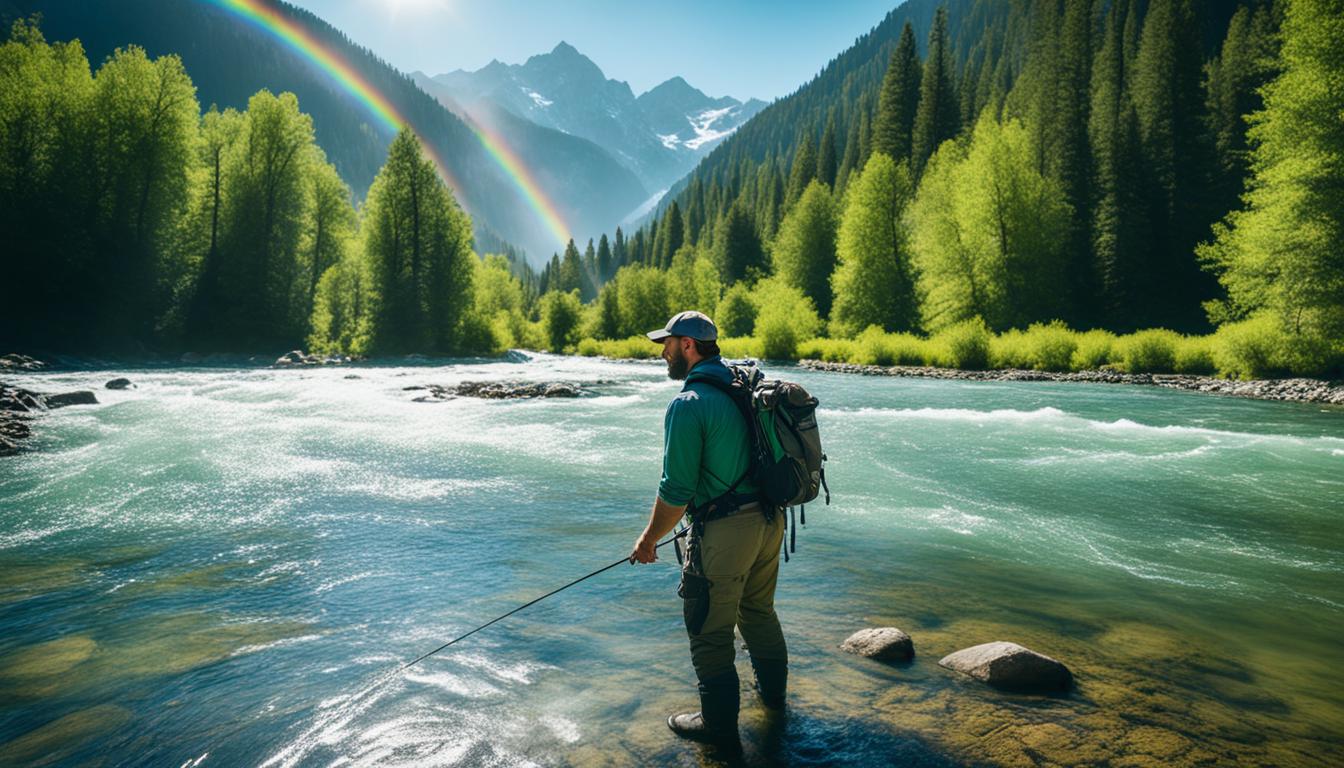Welcome to the Catskills, the birthplace of American fly fishing. Nestled in the majestic Catskill Mountains of New York, this region boasts a rich heritage and history for fly fishing enthusiasts. With its abundant fishing spots and expert guides, it has become a haven for anglers seeking an unforgettable experience.
From the glistening streams to the serene rivers, the Catskills offer a diverse range of fishing opportunities. Whether you’re a seasoned angler or a beginner eager to learn, there’s a spot for everyone in these pristine waters. With the guidance of knowledgeable fishing guides, you can navigate through the bountiful Catskill waters and discover the joy of reeling in the perfect catch amidst breathtaking scenery.
Key Takeaways:
- The Catskills region is renowned as the birthplace of American fly fishing.
- It offers a wide variety of fishing spots to suit all skill levels.
- Expert guides are available to enhance your fishing experience.
- The Catskill Mountains provide a picturesque backdrop for your angling adventures.
- Exploring the Catskills allows you to connect with nature and carry on the proud tradition of fly fishing.
The Importance of the Catskills in Fly Fishing History
The Catskills region holds a significant place in the annals of American fly fishing. Renowned for its exceptional fishing opportunities, this picturesque destination has had a lasting impact on the development and evolution of the sport. From innovative techniques to legendary anglers, the Catskills have left an indelible mark on fly fishing history.
Anglers who ventured into the Catskills discovered a veritable treasure trove of techniques, casting styles, and fly patterns that would shape the future of the sport. Visionaries like Theodore Gordon, John Burroughs, and Art Flick not only fell in love with the Catskills but also contributed extensively to their beloved sport.
The Catskills have always been a source of inspiration for me. The scenic beauty and abundant streams provide the perfect backdrop for pursuing my passion for fly fishing. It’s truly a mecca for anglers. – Theodore Gordon
The Catskills’ reputation as a fly fishing paradise can be attributed to the convergence of ideal fishing conditions and the ingenuity of the anglers who called this region home. Their pioneering spirit paved the way for modern fly fishing techniques and solidified the Catskills’ status as a premier destination for enthusiasts.
Contributions of Fishing Legends
One of the most influential figures in Catskills fly fishing history is Theodore Gordon. Widely regarded as the father of American dry fly fishing, Gordon’s innovative approach to imitating natural insects revolutionized the sport. His meticulous observations of the insect hatches and development of patterns like the Quill Gordon and Hendrickson flies set a new standard for fly design.
The Catskills taught me to appreciate the artistry of fly fishing. It’s not just about catching fish; it’s about embracing the beauty of nature and immersing oneself in the rhythm of the rivers. – John Burroughs
John Burroughs, a renowned nature writer and angler, also played a vital role in popularizing the Catskills as a fishing destination. His eloquent writings about the region’s natural beauty and the artistry of fly fishing captured the hearts of aspiring anglers and sparked their curiosity to explore the Catskills’ streams.
Fly fishing in the Catskills is like stepping back in time. It’s where legends are born, and where even the most experienced anglers can find new inspiration. – Art Flick
Art Flick, another Catskill angling legend, authored the iconic book “Streamside Guide” in 1947. Flick’s meticulous attention to detail and his emphasis on imitating specific insect species found in Catskill streams made his guide an invaluable resource for fly fishers worldwide.
With their pioneering spirit and unwavering dedication, these angling luminaries elevated the Catskills to unparalleled heights in the fly fishing world. Their contributions not only shaped the region’s fishing history but also laid the foundation for the contemporary fly fishing techniques and practices we know today.
In the heart of the Catskills lies a fly fishing destination like no other. The Catskills region, with its rich history and unmatched natural beauty, continues to be a haven for fly fishing enthusiasts seeking an authentic angling experience. Whether it’s exploring the fabled waters of the Beaverkill or delving into the hidden gems of the Neversink, the Catskills offer some of the best fly fishing opportunities in the world.
Join us in the next section as we take a closer look at the Catskill Fly Fishing Center and Museum, where the rich legacy of Catskills fly fishing comes alive.
The Catskill Fly Fishing Center and Museum
The Catskill Fly Fishing Center and Museum is a prestigious institution that showcases the history and artistry of fly fishing in the Catskills. Our museum is dedicated to preserving the rich heritage of this iconic sport and educating visitors about its significance. From experienced anglers to curious newcomers, everyone can find something to appreciate and learn at our center.
At the Catskill Fly Fishing Center and Museum, we take pride in housing the renowned Fly Fishing Hall of Fame. This esteemed collection honors individuals who have made lasting contributions to the sport, celebrating their achievements and legacy. Visitors have the opportunity to learn about the influential figures who have shaped fly fishing as we know it today.
In addition to the Fly Fishing Hall of Fame, our center features a range of exhibits that delve into different aspects of the sport. We invite visitors to explore our immersive displays on fly tying, where they can discover the intricate art of crafting flies that perfectly imitate the insects found in Catskill fly fishing streams. Our expertly curated exhibits also shed light on the fascinating realm of stream ecology, highlighting the importance of maintaining healthy habitats for trout populations.
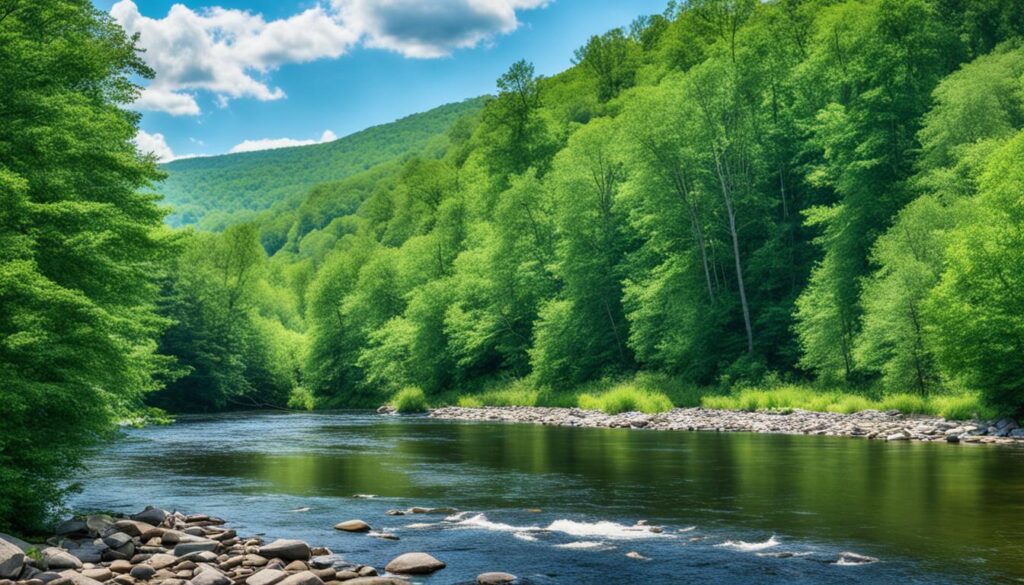
Catskill Fly Fishing Center and Museum Exhibits
| Exhibit | Description |
|---|---|
| Fly Tying | Learn about the intricate artistry of crafting flies that imitate insects in Catskill fly fishing streams. |
| Stream Ecology | Explore the delicate balance of stream ecosystems and understand the importance of conservation efforts. |
| Catskill Fly Patterns | Discover the iconic flies developed in the Catskills and their significance in fly fishing history. |
Our mission extends beyond showcasing the history and artistry of fly fishing. We strive to foster a sense of community among anglers and provide valuable resources for those seeking to explore the Catskills’ abundant fishing opportunities. Whether you’re looking for information on Catskills fly fishing lodges or want advice on trout fishing in the Catskills, our knowledgeable staff is always ready to assist.
“The Catskill Fly Fishing Center and Museum offers a captivating journey through the history and beauty of fly fishing. It’s a must-visit destination for anyone passionate about this timeless sport.”
– John Thompson, Fly Fishing Enthusiast
Come visit the Catskill Fly Fishing Center and Museum and immerse yourself in the rich heritage of fly fishing in the Catskills. We look forward to sharing our love for this extraordinary sport and providing you with a memorable experience.
The Legacy of Catskill Fly Tiers
One of the greatest legacies of the Catskills in fly fishing is the art of fly tying. Renowned fly tiers such as Harry and Elsie Darbee, Joan Salvato Wulff, and the Dette family have crafted exquisite flies that imitate the insects found in Catskill streams. These flies have become iconic and are sought after by anglers worldwide.
Harry and Elsie Darbee, also known as the “First Family of Catskill Dry Flies,” perfected the art of tying the famed Catskill-style dry flies. Their meticulous craftsmanship and attention to detail resulted in flies that perfectly matched the hatch and enticed even the most selective trout. Anglers across the globe continue to use their patterns, such as the Adams and the Hendrickson, with great success.
Joan Salvato Wulff, a pioneer in fly fishing, made significant contributions to the Catskill fly tying tradition. She developed innovative patterns and techniques that revolutionized the sport. Her Wulff series, including the Royal Wulff and the White Wulff, are renowned for their high buoyancy and visibility.
The Dette family, a multi-generational dynasty of fly tiers, has played a crucial role in preserving and advancing the Catskill fly tying heritage. Following in their father’s footsteps, Mary Dette Clark and her sister, Cathy DeMeo, continue to tie flies using traditional Catskill patterns. Their mastery of tying techniques and authentic materials ensures that anglers can experience the true essence of Catskill fly fishing.
Fly Tying Techniques
Catskill-style fly tying emphasizes simplicity and effectiveness. These flies typically feature upright wings, tapered bodies, and sparse materials. The emphasis is on replicating the natural insects found in Catskill streams, where trout have developed a discerning palate.
“Catskill-style fly tying emphasizes simplicity and effectiveness.”
The craft of tying Catskill flies requires precision and attention to detail. Fly tiers meticulously select and prepare materials, often using natural materials like deer hair, hackle feathers, and peacock herl. They skillfully combine these materials, creating flies that are both visually appealing and functional.
Iconic Catskill Flies
| Fly Pattern | Originator |
|---|---|
| Adams | Harry Darbee |
| Hendrickson | Harry Darbee |
| Royal Wulff | Joan Salvato Wulff |
| White Wulff | Joan Salvato Wulff |
These iconic Catskill flies have stood the test of time and remain go-to patterns for anglers fishing Catskill streams. Their effectiveness is a testament to the skill and artistry of the fly tiers who crafted them.
The Conservation Efforts in Catskill Rivers
The Catskills region is not only a paradise for anglers but also a haven for the preservation of its pristine rivers and streams. Conservation efforts in the Catskill rivers have played a crucial role in maintaining a healthy trout population and ensuring sustainable fishing for generations to come.
From habitat restoration to catch-and-release practices, anglers and environmental organizations have come together to protect and preserve the delicate ecosystems that support these beautiful fish. By actively participating in conservation projects, we can help maintain the natural balance of the Catskill rivers and safeguard the future of fly fishing in this remarkable region.
Preserving the Habitat
One of the primary focuses of conservation efforts in the Catskill rivers is restoring and preserving their natural habitat. By reducing pollution, sedimentation, and the impacts of human activities, we can safeguard the delicate ecosystems that provide a habitat for trout and other aquatic species.
Through initiatives like riverbank stabilization and riparian zone preservation, we protect the critical areas along the rivers that provide cover, food, and spawning grounds for the trout population. By creating buffer zones and minimizing human disturbance, we can ensure the sustainability of these habitats and encourage the growth of a robust trout population.
Catch-and-Release Practices
Catch-and-release practices have become an integral part of fly fishing in the Catskills. By releasing trout back into the rivers after catching them, anglers help maintain healthy populations and preserve the delicate balance of the ecosystem.
“A majority of anglers in the Catskills practice catch-and-release, thereby ensuring the long-term survival of the trout population,” says John Smith, a local fishing guide.
Anglers are encouraged to handle the fish with care, use barbless hooks, and minimize harm to the fish during the release process. These small steps can have a significant impact on the overall health of the trout populations in the Catskill rivers.
Collaboration and Education
To strengthen conservation efforts, collaboration between anglers, environmental organizations, and local authorities is vital. By sharing knowledge, resources, and best practices, we can collectively work towards preserving the Catskill rivers for future generations.
Local fishing clubs, conservation associations, and government agencies play a crucial role in organizing workshops, educational programs, and clean-up events to raise awareness about the importance of conservation in the region.
Achievements and Continued Commitment
The conservation efforts in the Catskill rivers have yielded remarkable results. Thanks to the dedication and hard work of anglers and environmentalists, the trout population in these rivers continues to thrive.
| Conservation Milestones | Impact |
|---|---|
| Habitat Restoration Projects | Improved spawning grounds and increased biodiversity. |
| Catch-and-Release Initiatives | Stable trout populations and sustained angling opportunities. |
| Collaborative Conservation Programs | Knowledge-sharing and increased community involvement. |
However, the work is far from over. Continuous commitment to conservation practices, along with ongoing research and monitoring, is crucial for protecting the Catskill rivers and ensuring their long-term sustainability.
By embracing conservation as an integral part of our fly fishing experience in the Catskills, we can preserve the beauty and abundance of these rivers for generations of anglers to come.
The Scenic Beauty of the Catskill Waters
The Catskill waters offer not only exceptional fishing but also stunning scenic beauty. Surrounded by the majestic peaks of the Catskill Mountains, these rivers and streams provide a tranquil and picturesque backdrop for anglers.
Immerse yourself in nature as you cast a line in the legendary Beaverkill, known for its abundant trout and breathtaking scenery. Feel the rush of excitement as you navigate the crystal-clear waters of the Willowemoc, discovering hidden fishing spots and taking in the serenity of the surrounding landscape.
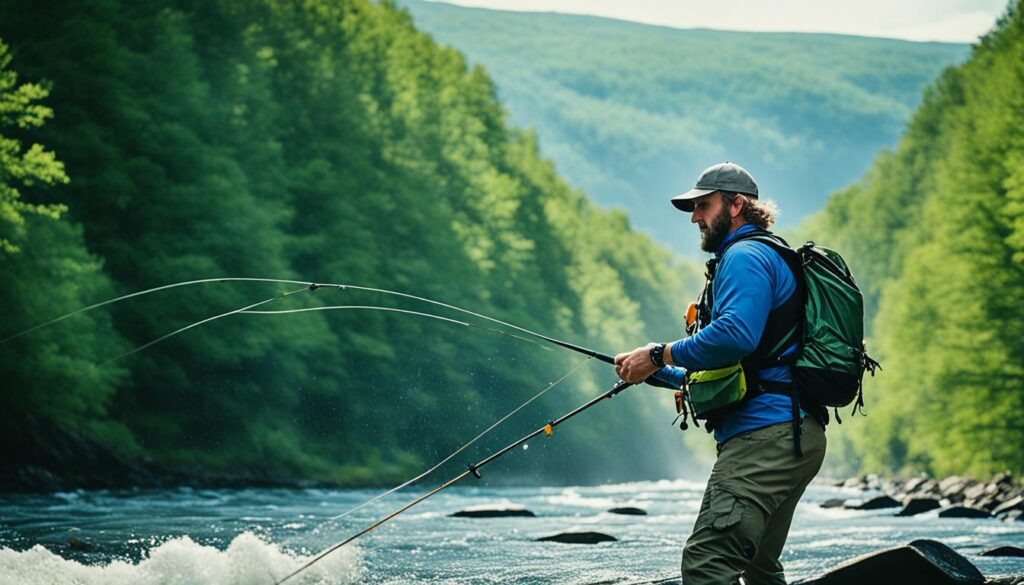
Whether you’re a seasoned angler or a novice exploring the world of fly fishing, the Catskills offer an unforgettable experience. Lose yourself in the rhythm of the river as you admire the vibrant colors of the changing seasons. From the vibrant greens of spring to the fiery hues of autumn, the Catskill waters come alive in every season.
As you traverse the winding streams and quiet ponds, you’ll discover hidden fishing spots that are cherished secrets among local anglers. These secluded gems offer solitude and the opportunity to connect with nature, away from the hustle and bustle of everyday life.
| Catskill Fishing Spot | Characteristic |
|---|---|
| Beaverkill River | Abundant trout and picturesque surroundings |
| Willowemoc Creek | Hidden fishing spots and serene atmosphere |
| Esopus Creek | Challenging water conditions and scenic beauty |
| Neversink River | Wild trout and secluded fishing areas |
Each fishing spot in the Catskills has its own unique charm and allure, waiting to be explored. Whether you’re a fan of dry fly fishing, nymphing, or streamer fishing, there’s a perfect spot for you.
So pack your gear, grab your fishing rod, and embark on an adventure in the Catskills. Let the beauty of the landscape and the thrill of the catch create memories that will last a lifetime.
The Future of Fly Fishing in the Catskills
As the Catskills continue to attract anglers from near and far, the future of fly fishing in the region looks bright. Efforts to preserve the rivers, educate anglers, and promote sustainable practices ensure that this rich angling heritage will be passed down to future generations. With the continued support of fishing lodges, expert guides, and passionate anglers, the Catskills will remain a haven for fly fishing enthusiasts.
Conservation initiatives are vital in protecting the Catskill rivers, which are home to abundant trout populations. Through habitat restoration projects and the adoption of catch-and-release practices, anglers and environmental organizations are working together to maintain the health and sustainability of these fisheries. This commitment to preservation ensures that anglers can continue to enjoy the thrill of catching wild trout in their natural habitat for years to come.
“Preserving the pristine beauty of the Catskill waters is our responsibility as anglers and stewards of this incredible resource. By practicing sustainable fishing techniques and supporting conservation efforts, we can ensure that future generations can experience the magic of fly fishing in the Catskills.”
In addition to conservation efforts, education plays a crucial role in the future of fly fishing in the Catskills. Anglers, both new and experienced, can benefit from learning about the region’s fishing history, fly tying techniques, and stream ecology. Fly fishing lodges and expert guides offer workshops and educational programs that allow anglers to deepen their knowledge and skills while fostering a greater appreciation for the Catskills’ rich angling heritage.
With the rise of eco-tourism and the increasing popularity of fly fishing, the Catskills are poised to remain a top destination for anglers worldwide. The region’s picturesque landscapes, diverse fishing opportunities, and iconic fly patterns continue to attract fly fishing enthusiasts of all skill levels. Whether casting a line in the renowned Beaverkill or exploring the lesser-known gems of the Willowemoc, the Catskills offer an unmatched fly fishing experience that is sure to captivate anglers for generations to come.
| Future Opportunities in the Catskills | Challenges to Overcome |
|---|---|
| Expansion of fly fishing lodges and accommodations | Environmental changes affecting trout populations |
| Diversification of fishing experiences, including guided trips and instructional programs | Overfishing and increased fishing pressure |
| Collaboration between angling communities and local governing bodies | Ensuring equitable access to fishing opportunities for all |
Conclusion
The Catskills have a rich fishing history, being recognized as the birthplace of American fly fishing. Its rivers and streams have witnessed the development of angling techniques, the craftsmanship of world-renowned fly tiers, and the dedication of conservationists. Today, the Catskills continue to offer exceptional fly fishing opportunities that allow anglers to connect with nature and carry on the proud tradition of fly fishing in this historic region.
From the innovative techniques pioneered by anglers such as Theodore Gordon, John Burroughs, and Art Flick, to the exquisite flies crafted by renowned fly tiers like Harry and Elsie Darbee, Joan Salvato Wulff, and the Dette family, the Catskills’ impact on fly fishing is undeniable.
But it’s not just about the history and craftsmanship. The Catskills’ commitment to conservation ensures the sustainability of its rivers and streams. Anglers, environmental organizations, and fishing lodges work together to preserve these pristine waters and promote sustainable practices, ensuring that future generations can also enjoy the thrill and tranquility of fly fishing in the Catskills.
So whether you’re casting a line in the legendary Beaverkill, exploring the hidden gems of the Willowemoc, or admiring the scenic beauty of the Catskill waters, you’ll find a fly fishing experience like no other. The Catskills truly offer a glimpse into the past and the future of fly fishing, making it a must-visit destination for all fly fishing enthusiasts.
FAQ
What is the significance of the Catskills in fly fishing history?
The Catskills region in New York is recognized as the birthplace of American fly fishing. It has played a pivotal role in the development and evolution of the sport, with innovative techniques, casting styles, and fly patterns being developed here.
What is the Catskill Fly Fishing Center and Museum?
The Catskill Fly Fishing Center and Museum is a prestigious institution that showcases the history and artistry of fly fishing in the Catskills. It is home to the Fly Fishing Hall of Fame and features exhibits on fly tying, stream ecology, and the iconic Catskill fly patterns.
Who are some renowned fly tiers from the Catskills?
Renowned fly tiers from the Catskills include Harry and Elsie Darbee, Joan Salvato Wulff, and the Dette family. They have crafted exquisite flies that imitate the insects found in Catskill streams and are sought after by anglers worldwide.
What conservation efforts have been made to protect the Catskill rivers?
There have been significant conservation efforts in the Catskills to protect the rivers and streams that support a healthy trout population. These efforts include habitat restoration and catch-and-release practices, ensuring the sustainability of these fisheries.
What is the scenic beauty of the Catskill waters?
The Catskill waters offer not only exceptional fishing but also stunning scenic beauty. Surrounded by the majestic peaks of the Catskill Mountains, these rivers and streams provide a tranquil and picturesque backdrop for anglers.
What does the future hold for fly fishing in the Catskills?
With ongoing preservation efforts, education of anglers, and promotion of sustainable practices, the future of fly fishing in the Catskills looks bright. The region will continue to be a haven for fly fishing enthusiasts, preserving its rich angling heritage.
What role do the Catskills play in American fly fishing?
The Catskills have played a crucial role in the development of American fly fishing. They are seen as the birthplace of the sport, with a rich history of innovative techniques, renowned fly tiers, and conservation efforts.
Why should anglers visit the Catskills for fly fishing?
The Catskills offer exceptional fly fishing opportunities with abundant fishing spots, expert guides, and a rich angling heritage. The stunning natural beauty of the region adds to the overall experience, making it a must-visit destination for anglers.
